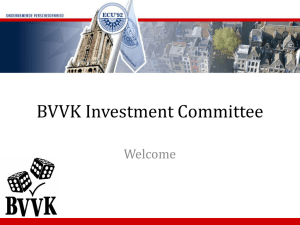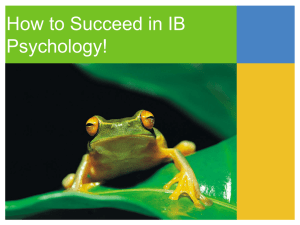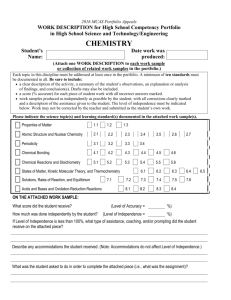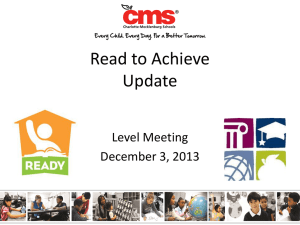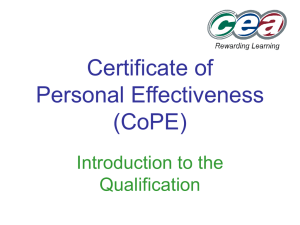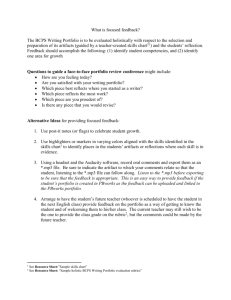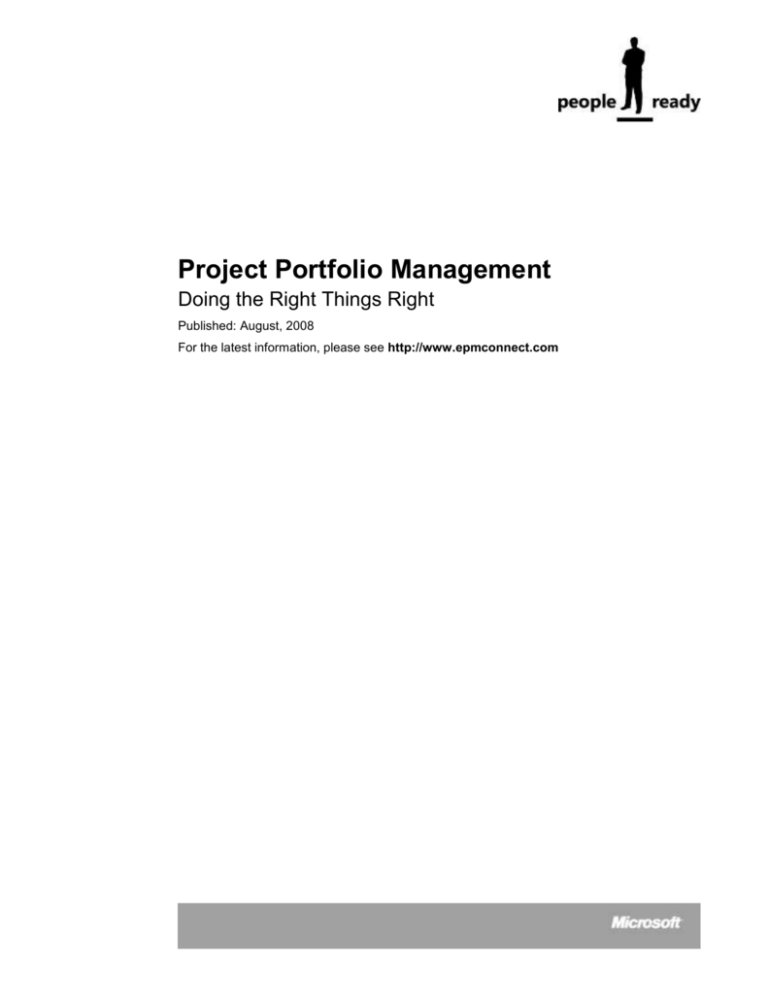
Project Portfolio Management
Doing the Right Things Right
Published: August, 2008
For the latest information, please see http://www.epmconnect.com
Contents
Introduction .................................................................................................................................1
What is Project Portfolio Management? .................................................................................2
Who participates in PPM, and how? ......................................................................................3
The PPM Governance Lifecycle: Create, Select, Plan, Manage ................................................4
Overview .................................................................................................................................4
Create .....................................................................................................................................6
Select ......................................................................................................................................7
Plan.........................................................................................................................................8
Manage ................................................................................................................................ 10
Building a Roadmap for Success............................................................................................. 12
Overview .............................................................................................................................. 12
PPM Capability Maturity Model ........................................................................................... 12
Creating a Roadmap ........................................................................................................... 13
The Microsoft EPM Solution .................................................................................................... 14
Overview .............................................................................................................................. 14
Manage and control all types of work .................................................................................. 15
Improve visibility and insight to enhance decision-making.................................................. 15
Effectively communicate and collaborate with all stakeholders .......................................... 16
Evolve with a scalable and configurable platform ............................................................... 16
Conclusion ............................................................................................................................... 17
Introduction
This paper introduces definitions, concepts, and frameworks for Project Portfolio Management
(PPM); describes how the Microsoft Enterprise Project Management (EPM) Solution supports
PPM; and provides initial guidance to executives and business leaders for PPM
implementation planning.
Large organizations have a need for well defined and effective IT Governance. Frequently, IT
executives are tasked with:
balancing demand from varying sets business customers
maintaining alignment with overall business objectives
delivering global stability while providing localized value
delivering value within exacting financial and resource constraints
PPM is a critical Governance capability that addresses all of these challenges.
The Microsoft EPM Solution is based upon Microsoft Office Project technology. Over the past
12 years, Microsoft Office Project has evolved from a desktop software product to a
comprehensive family of network-based solutions.
Evolution of Microsoft Office Project
For additional details about the Microsoft EPM Solution and to find resources for PPM
implementation, please visit the EPMConnect website at http://www.epmconnect.com.
EPMConnect puts the resources of hundreds of Microsoft Enterprise Project Management
partners at your fingertips, enabling you to quickly locate the right solutions and services and
connect with the ideal EPM partner for your needs.
Doing the Right Things Right
1
What is Project Portfolio Management?
Project Portfolio Management (PPM) is the continuous process of
identifying, selecting and managing a portfolio of projects in alignment with
key performance metrics and strategic business objectives.
PPM is about “doing the right things right”. For the purposes of this document, the following
definitions are provided:
“Things” refers to: work efforts, projects, and programs. Work efforts are the tasks and
activities required to operate a business. A project – according to the Project Management
Institute (PMI) definition – is “a temporary endeavor undertaken to create a unique product or
service”. A program is “a group of related projects managed in a coordinated way to obtain
benefits and control not available from managing them individually. Programs may include
elements of related work outside the scope of the discrete projects in a program.” (PMI).
“Doing the right things” refers to prioritizing and selecting programs and projects to achieve
your organizational objectives.
“Doing things right” means delivering high quality projects or programs
By further breaking down these simple statements there are some interesting questions that arise.
“Doing the right things” is Governance enabled by Portfolio Management
What are the “right things”?
Are we doing things that we should not be doing?
Are there things we should be doing that we’re not?
How can we improve our decision-making?
“Doing things right” is Execution enabled by Project Management / Work Management
What is the right way to do something?
How do I make sure we do things right?
How can we improve what we do?
One overarching question is: What is the impact of improving portfolio management vs. project
management? The following diagram shows the relationship between portfolio management, project
management, and overall potential value that an organization can deliver:
In this example, the current portfolio management capabilities are at 66% with 100% representing a
perfect ability to select the right projects. The project management capabilities are at 75%, with 100%
representing a perfect ability to deliver projects on time, on scope, and on budget. With these assumed
these levels of capability, an organization is only realizing 50% of total potential value from its efforts.
Doing the Right Things Right
2
PPM is comprised of two equally important disciplines; project management and portfolio management.
The benefits of project management are more clearly understood. Traditional project management is a
discipline that helps organizations to effectively realize business value, by delivering projects and
programs on time and within budget. Less is known about portfolio management. Many people believe
that portfolio management just involves effective reporting across project portfolios. This is certainly an
important aspect, but portfolio management also helps organizations to identify business value and
ensure they are investing in the optimal project portfolios. In other words, portfolio management helps
you to select the right things and project management ensures you execute and deliver the projects on
time and within budget. Successful organizations invest in improving both disciplines.
Who participates in PPM, and how?
PPM is for organizations that have large numbers of investments, and a need for improved
governance or execution. It is generally the concern of three groups of people within an
organization: executives, managers, and project teams.
Executives – includes executives and portfolio managers. Executives have the
responsibility to set strategy and direct the organization to meet its objectives.
Frequently, there is a Portfolio Manager involved in supporting executives to organize
and operate PPM.
Managers – includes the Project Management Office (PMO), Resource Managers,
and Project Managers. This group is responsible for the planning and successful
execution of projects and programs.
Project Teams – are the set of people assigned to a project to perform tasks and
produce deliverables.
The following pyramid diagram shows these three groups in the context of PPM. To the right
of the triangle, major components and benefits of PPM are shown. Core PPM processes are
shown to the right of the triangle.
Doing the Right Things Right
3
The PPM Governance Lifecycle: Create, Select, Plan, Manage
Overview
Assigning the right resources to the right activities at the right time – in other words, alignment
– is the ultimate goal of business governance. An organization’s strategy, operational
structure, execution process and technical expertise are all tested when resource
assignments are made. Portfolios, programs and projects are all formal expressions of
resource assignment decisions. Accordingly, a systematic approach to collecting, selecting,
planning and managing them is key to a high-quality IT Governance process.
Portfolios, programs and projects all share a common lifecycle. This lifecycle is formed
around four key PPM gates, ‘Create → Select → Plan → Manage’.
Create: Standardized intake process and data collection structures for formation of
the project portfolio inventory. Formal definition of strategic goals and objectives to
support portfolio prioritization and selection.
Select: Repeatable process for prioritization of the project portfolio. Decision-making
for progression, suspension or rejection of work requests.
Plan: Scheduling and resource assignment processes for the entire project portfolio,
supported by detailed project planning.
Manage: Ensuring successful project delivery, ongoing project tracking and reporting;
and portfolio realignment
This simple framework can serve as a foundation for evaluating and improving governance
practices. Organization-wide adoption of the ‘Create, Select, Plan, Manage’ lifecycle leads to
consistent definition and common understanding of its underlying core processes:
Doing the Right Things Right
4
Demand Management – starts with having standard methods and structures for
capturing all work ranging from simple support or change requests, to large complex
projects and programs. Demand Management also includes definition of workflow for
proper categorization, evaluation and characterization of the work request.
Portfolio Selection – is the process of evaluating a portfolio of project requests,
prioritizing the requests and approving or rejecting requests. To determine the best
combination of projects, portfolio managers should use multiple criteria and analyses,
including strategic, financial and risk. A portfolio selection that maximizes the
portfolio’s value (as determined by the relevant criteria) given budget or resource
constraints is considered “Optimized”.
Capacity Planning – is a continuous process of evaluating an organization’s
resources and performance to determine its capacity for production of work. It
includes setting utilization targets for defined sets of people – usually by title and/or
skill set. It also includes a collection of project metrics to understand productivity and
subsequent adjustment of utilization targets. Proactive capacity planning allows
organizations to finalize a release roadmap that maximizes resource utilization
Resource Management – is about the assignment of resources to projects and
tasks. For large organizations, this is typically an elaborate process that includes
shuffling of resources to meet demands of project delivery schedules and project
priorities.
Financial Management – exists at both the project and portfolio levels. At the
project level, financial management is the estimation of project costs and benefits,
and tracking project expenditures against the project budget. At the portfolio level,
financial management focuses on gaining visibility into spend (committed, planned
and discretionary) and tracking the overall project portfolio budget.
Project Scheduling – includes developing accurate project schedules; and defining
repeatable best practice efforts. These two activities reinforce efforts to understand
interdependencies between project schedules.
Time Reporting – provides structures and methods for individual reporting of time
spent on projects or tasks by resources. This information feeds project and portfolio
reporting and provides visibility into the actual work progress, current work status and
remaining work.
Team Collaboration – in PPM, is the structured sharing of information to support
knowledge sharing, change management, communication of schedule milestones,
issues and risk management.
Portfolio Reporting – provides visibility of the project portfolio to executives and
functional leaders. To support sound decision-making and operational efficiency, a
common view of projects and priorities is essential. By having executives, PMOs,
and project managers share a common view of the organization, inefficiencies due to
conflicting information are minimized and discussions can be focused on valueadding portfolio analysis.
Project Reporting – helps to ensure consistent tracking of projects and efficient
communication of project objectives and status.
Program Management – can be viewed as management of large initiatives
comprised of multiple projects. Programs should be aligned with an organization’s
strategy and the results of a program are produced through the delivery of its projects
By examining the core processes within the context of each major lifecycle step (Create,
Select, Plan, Manage), definitions of key benefits and capabilities emerge.
Core PPM Processes Overview
Create
The Create lifecycle phase encompasses activities for the definition of strategic goals and
metrics, and intake of work demand. The most relevant core PPM processes in the Create
step are:
Demand Management – Definition of business case structure, business case
creation and workflow to support evaluation of work requests
Portfolio Reporting – During the Create phase, portfolio reporting includes reports
that provide visibility of all demand captured within a planning cycle. Information
conveyed in the portfolio reports help to characterize the overall portfolio inventory
Team Collaboration – During the Create phase, informal teams or communities can
collaborate to share ideas and capture project requests. For example, a team might
identify a gap in operations then request a project to address the gap. Executives
and PMOs can communicate with managers and teams to publicize corporate goals,
significant events and upcoming PPM reviews
Program Management – Similar to projects, program definitions can be formed
during the Create phase. Some organizations define programs as part of an annual
budget allocation cycle. Each program definition represents a high-level business
objective that can be broken down into more specific business objectives.
Throughout the budget year, programs objectives are pursued by creating projects
that each address a subset of the program objectives. This facilitates delegation of
governance control to the program level.
Key benefits and capabilities:
Capture all requests, from work orders to discretionary projects – Consolidating
requests in a single central repository provides visibility and control to your
organization’s entire workload. This is required for maintaining a single source of
truth for work demand and for making informed allocation decisions
Doing the Right Things Right
6
Standardize metrics, valuation criteria and templates – Standardization allows for
consistent methods in evaluation and decision-making. Structured templates,
consisting of standard metrics and valuation criteria, support an end-to-end flow of
information throughout the PPM process. This flow ranges from business case
creation to portfolio and project reporting
Control investment through governance workflow – The proper evaluation of
business cases includes validation of the information provided by the appropriate
authority; business case review by key stakeholders; and approval from the
appropriate governing bodies. Routing and tracking business cases can be simplified
through structured workflows. These review and approval processes can vary
depending upon the investment type (e.g., big or small project) requiring a unique
review and approval workflow for each type
Select
After a project portfolio inventory has been formed in the Create lifecycle phase, the Select
phase is next. It includes all activities related to go/no-go decision-making and the
prioritization of requested programs and projects. The most relevant core PPM processes for
the Select phase are:
Portfolio Selection – Key metrics in a project portfolio inventory are used to collate
the project portfolio into analysis sets; examine project valuation (e.g., strategic,
financial); and perform analyses (e.g., constraints, what-if’s). The analyses are used
by a governance committee to select the investments that best align with the
organization’s strategic priorities
Financial Management – Budgetary constraints are key inputs for the Select phase.
Decisions made during the phase also feed financial planning as programs and
projects are approved and budget allocations are made
Portfolio Reporting – Reporting supports portfolio selection discussions by providing
a common and consistent view of the entire project portfolio to decision-makers.
Information reported during the Select phase includes: project ranking based on
varying valuation criteria (e.g., strategic alignment, financial valuation), and charting
to show the results of constraint and what-if portfolio analyses
Team Collaboration – As prioritization and selection discussions take place, there is
an exchange of questions and answers between executives, PMOs, project
managers and other stakeholders. Good collaboration during this exchange yields a
deeper understanding of and improved confidence in the project portfolio information.
This includes efficiently handling portfolio data Q&A, pressure testing key
assumptions and socialization of decisions
Program Management – During the Select phase, this includes activities for the
prioritization of programs and the inclusion of program-oversight in the go/no-go
project decision-making process. Different organizations have different approaches
for managing the portfolio-program-project relationship. Some may take the
approach of prioritizing programs before identifying projects. Prioritizing programs is
accomplished by analyzing the portfolio of programs. This can be done in addition to
analyzing the project portfolio
Key benefits and capabilities:
Objectively prioritize business drivers and drive consensus – Open discussion of
business strategy and prioritizing strategic objectives with governance bodies
contributes to a better aligned organization and leads to more effective decisionmaking discussions
Doing the Right Things Right
7
Derive varying priority scores to evaluate competing investments – By
comparing objective priority scores (e.g., financial valuation, strategic alignment
score) across projects, fact-based decision-making discussions are made possible
Identify portfolios that align with strategy and maximize ROI – Maximizing
portfolio return starts with optimizing the selection of projects to pursue. Portfolio
selection that includes consideration of strategic alignment and financial return helps
ensure that long-term health is not compromised for short-term gain
Adopt a rational rather than emotional portfolio selection methodology – With
structured project portfolio valuation criteria, discussing points of contention can be
focused on specific key factors. The overall structure and visibility of the entire
project portfolio illuminates the impact of forcing in pet projects as the implications of
tradeoffs quickly surface
Utilize advanced portfolio analytical techniques to reach the efficient frontier –
For any investment level there is an optimal selection of projects that will yield the
greatest value. Mapping the maximum portfolio value (e.g., strategic value or
financial value) for a range of investment combinations is called the ‘efficient frontier’.
Advanced portfolio analysis employs this concept to measure the impact of project
selection decisions as well as the impact of breaking constraints (e.g., what-if we had
$2M more to spend?)
Plan
The Plan lifecycle phase includes activities to both plan and also perform resource
assignment. This can be viewed from two perspectives – a portfolio perspective and a project
perspective. From a portfolio perspective, activities during the Plan phase revolve around
overall capacity planning and maintenance of project portfolio delivery schedule. From a
project perspective, the Plan phase involves detailed project planning and assignment of
named resources to the project. The most relevant core PPM processes for the Plan phase
are:
Capacity Planning – This is a key component of the Plan phase. It includes:
identifying peaks and valleys in overall resource demand by skill level; evaluating
resource supply by skill level; adjusting the project portfolio delivery schedule to
minimize resource deficits and surpluses; and finalizing headcount decisions.
Resource Management – Rules of engagement are needed to perform named
resource assignment at a project level. This includes how specific, named resources
are matched to work demand; how their availability is forecasted; how assignments
are made and communicated; and how resource conflicts are resolved. These rules
are exercised and enforced through resource management.
Project Scheduling – During the Plan phase, an approved project is scheduled to
start on a specific date, when a baseline plan is established. To establish a baseline
plan, first a detailed plan is created. This is accomplished by defining the project’s
work breakdown structure (WBS); identifying dependencies and constraints
associated with the WBS; and defining detailed resource requirements (e.g., by skill
or name). Based on this detailed plan, resource assignments and the overall project
schedule are both finalized. At this point, the detailed plan becomes the baseline
plan. This baseline is the foundation for ongoing schedule management.
Financial Management – During the Plan phase, financial management is primarily
concerned with forecasting spend and aligning spend with budgets. Project-level
planning and forecasting is an essential input to the overall spend forecast. This
includes with well-formed project schedules, resource estimates and cost estimates.
Doing the Right Things Right
8
Portfolio Reporting – Portfolio-level reporting during the Plan phase includes
resource utilization forecasts to identify resource under/over utilization; overviews of
project schedules to view timing of overall project portfolio delivery; and spend
forecasts
Project Reporting – Project-level reporting starts during the Plan phase with the
formation of a Project Charter. Project charters detail the scope, objectives, schedule
and resources needed for successful project execution. At the project’s end, project
performance can be measured by comparing project results with estimated benefits
from the Project Charter
Team Collaboration – Planning the start of projects requires tight coordination
between decision-makers (executives via PMOs), project managers, resource
managers and project team members. Collaboration is needed to ensure the clarity
of decisions, priorities and resource assignments
Program Management –Similar to the overall planning of the portfolio schedule,
organizations that define programs will develop program schedules. A program
schedule is assembled from the schedules of the individual project within the
program. During the Plan phase, detailed plans for the program’s underlying projects
are created and baselined
Key benefits and capabilities:
Identify gaps between overall resource availability and demand at the skill level
– Predicting resource utilization is a key input for capacity planning. Without proper
capacity planning, an organization will have very limited capability to pursue long term
strategic initiatives. This is a portfolio-level capability
Finalize and release roadmap and headcount requirements to maximize
resource utilization – A release roadmap communicates the results of capacity
planning and provides direction to project managers and resource managers. Using
the release roadmap, project managers can coordinate resources assignments and
clarify priorities with resource managers. This is a key step where decisions and
priorities translate into an actual schedule. Resource managers and project
managers need this visibility to avoid resource conflicts. This is a benefit across all
divisions within the organization
Search for team members with availability and assign to project – With the
appropriate resource management capabilities in place, project managers can quickly
assess the fit and availability of resources to projects and project tasks and make
specific named resource assignment decisions. This is a key point where the detailed
project planning, resource management, and portfolio decisions and priorities
converge and transition into action
Finalize plan and baseline before moving into execution – Establishing a baseline
plan is critical to ongoing management of a project. With a baseline plan,
expectations are set across all project stakeholders
Doing the Right Things Right
9
Manage
The Manage lifecycle phase includes activities to support the delivery of projects and to track
the progress of projects. Quality delivery of projects is typically measured by the project’s
performance in delivering on scope, within budget and on schedule. Naturally, tracking of
projects is focused on monitoring forecasted deviations in scope, budget and schedule. The
most relevant core PPM processes in the Manage phase are:
Resource Management – During the Manage phase, resource management
primarily occurs at the project level and involves the on/off-boarding of project team
members and assignment of resources to tasks
Project Scheduling – Relative to the project schedule baseline, schedule tracking
and schedule forecasting take place on an ongoing basis throughout project
execution. This is another key component for managing successful project delivery
Financial Management – Tracking of actual project spend, and forecasting future
project spend is required to ensure a project is working within its financial constraints.
It also contributes to tracking overall portfolio performance
Time Reporting – Reporting of actual time spent on a project allows project
managers to track progress. Tracking of remaining budget and forecasting estimates
to complete helps to provide an overall picture of progress and to anticipate project
issues
Portfolio Reporting – Managing the execution of an entire project portfolio depends
on tracking the entire project portfolio’s status and removing the obstacles hindering
the project teams. Periodic, succinct and accurate portfolio reporting is vital to highquality portfolio management. Typically, portfolio reporting is the foundation for
leadership team meetings throughout the budget year. This includes overall project
portfolio status, budget status, scope status and schedule status
Project Reporting – Project managers are responsible for communicating the
progress and status of their project to multiple stakeholders: project sponsors,
beneficiaries, divisional managers and the project team. Standardized project status
reports promote easier and clearer communication to and between stakeholders
Team Collaboration – Collaboration reduces execution risk and fosters project
success. Today, project teams usually exist within a matrix organizational structure.
In these structures each team member has multiple reporting lines and affiliations: to
their project team; functional division; or region. Consequently, sharing of knowledge
and resolution of project issues and risks can take circuitous routes. Furthermore, in
global organizations, teams are frequently challenged with working across large
geographic regions and time zones. Good collaboration within a project team, across
functional divisions and across regions is essential for expediting issue resolution and
for effective knowledge sharing throughout the organization
Program Management – Overall health of a program is dependent on the status of
the projects within it. Similarly, changing scope or priority of a program will have a
broad impact on all of its projects
Key benefits and capabilities:
Collaborate to effectively deliver selected projects – During project execution,
there are always minor deviations from plans due to situational changes or the
emergence of issues. Collaboration helps to address and avoid these deviations by
bringing the right people together to work on a task or issue. Effective collaboration is
a pre-requisite for a high performing team
Doing the Right Things Right
10
Proactively monitor portfolio performance and visualize trends – Visibility into
the overall project portfolio performance provides executives with a mirror of their
organization and a true picture of what the organization is doing to realize its strategy.
This is an important perspective that feeds recalibration of priorities and goals
Drill down to the project level to assess risks, issues, and status – This
facilitates better coordination within the project team and with project stakeholders
Track and compare budget, actual and forecast values and make corrective
actions to improve project performance – Tracking and forecasting project
activities enables a project team to identify deviations from plan and to take corrective
action
Re-optimize the portfolio to maintain alignment with business strategy – An
organization’s business context fluctuates as the delivery of the project portfolio
progresses. Market forces can produce new priorities; business health can change
assumptions about dollar or resource constraints; killed projects affect both resources
availability and strategic alignment. Periodic, ongoing re-optimization of the project
portfolio is needed to ensure project portfolio delivery continues to be aligned with the
organization’s strategy
Doing the Right Things Right
11
Building a Roadmap for Success
Overview
The advantage of understanding and using the ‘Create → Select → Plan → Manage’
governance lifecycle is that it provides a simple framework for improving PPM capabilities.
After evaluating your organization’s capability maturity for each phase in the ‘Create → Select
→ Plan → Manage’ framework, you can identify areas for improvement by assessing your
current state and defining your future state. Furthermore, this assessment can be organized
into three areas of evaluation – people, process, and tools.
Dividing the landscape of PPM into the areas of lifecycle, capability maturity and assessment
dimensions allows for the definition of an initial, workable set of PPM implementation
activities. Subsequent phases of activities can also be planned using the same framework.
Typically, a phased approach for implementation is needed to allow for proper adoption
across a large enterprise.
PPM Capability Maturity Model
Planning a PPM implementation starts with an assessment of current PPM capabilities.
Capabilities can be evaluated within each phase in the ‘Create → Select → Plan → Manage’
framework. Defining a desired future state using the same framework helps to identify areas
for improvement. The following diagram shows an example of a “PPM Capability Maturity
Model”. The example shows, for each PPM lifecycle step, a current state assessment of an
organization’s capability maturity from “Initial” to “Optimized”. The stages of maturity are
based on the Carnegie-Melon SEI Capability Maturity Model (CMM).
Example Maturity Assessment and Future State Definition
As described in the above example, implementation of the PPM future state definition can be
planned as a multi-phased implementation. With a phased approach, an organization can
“right-size” their PPM implementation efforts. For example, it’s not necessary for an
Doing the Right Things Right
12
organization to reach the highest levels of maturity across all areas. A phased approach also
allows time for the organization to absorb change.
The Microsoft EPM Solution provides a flexible solution architecture that can be tailored to
match the objectives in each phase of a multi-phased PPM deployment.
Creating a Roadmap
Using the PPM Capability Maturity Model from the previous section, the gaps between current
state and desired future state will indicate where implementation efforts need to be focused.
Wider gaps will require more effort for designing the solution, engaging stakeholders in
change and training. Before determining the scope of PPM implementation phases, an
organization should envision an overall roadmap. Typically, a PPM implementation roadmap
presents one of two general paths: top down, or bottom up.
A top down approach – portfolio management first, project management next – is applicable
for organizations with a greater need for overall visibility and control of investments versus a
need for improved project execution practices. A top-down approach might follow this path:
Implementing Create and Select processes first (rolling-out MS Office Portfolio Server mostly
for Executives and Managers) and then Plan and Manage processes (rolling-out MS Office
Project Server and Project Professional for Team Members and Project Managers)
Conversely, a bottom up approach – project management first, portfolio management next –
is more applicable for organizations that require more support for project execution and have
less need for portfolio management. A bottom up approach could be: Implementing Plan and
Manage processes first (rolling-out MS Office Project Server and Project Professional mostly
for Managers and Team Members) and then Create and Select processes (rolling-out MS
Office Project Server and Project Professional for Executives)
There are generally two approaches to implementing the
entire MS EPM Solution – top down & bottom up.
Doing the Right Things Right
13
The Microsoft EPM Solution
Overview
The Microsoft Office Enterprise Project Management (EPM) Solution is an end-to-end
collaborative project and portfolio environment. The Office EPM Solution helps your
organization gain visibility, insight and control across all work, enhancing decision-making,
improving alignment with business strategy, maximizing resource utilization and measuring
and helping to increase operational efficiency.
The Office EPM Solution includes the following products from the Microsoft Office Project
2007 family to provide organizations with an end-to-end project portfolio management (PPM)
solution:
Microsoft Office Project Professional 2007: Microsoft Office Project Professional 2007
includes all the capabilities in Microsoft Office Project Standard 2007. Office Project
Professional 2007 gives you robust project management tools with the right blend of
usability, power and flexibility, so you can manage projects more efficiently and
effectively. You can stay informed, control project work, schedules and finances, and
keep project teams aligned, while becoming more productive through powerful reporting
options, integration with familiar Microsoft Office system programs, guided planning,
wizards and templates. In addition, Office Project Professional 2007 provides EPM
capabilities when connected to Microsoft Office Project Server 2007
Microsoft Office Project Server 2007: Microsoft Office Project Server 2007 is the
flexible platform that supports the resource management, scheduling, reporting, and
collaboration capabilities in the Office EPM Solution. Office Project Server 2007 enables
organizations to store project and resource information centrally and consistently. It also
integrates with Microsoft Windows SharePoint Services 3.0 for file management and
collaboration capabilities, helping team members to work together more effectively.
Further, based on their roles, users can access data and functionality via the Internet with
Microsoft Office Project Web Access
Microsoft Office Project Portfolio Server 2007: Microsoft Office Project Portfolio Server
2007 is a top-down portfolio management solution that helps organizations to realize their
potential by identifying, selecting, managing, and delivering portfolios that best align with
their business strategy. Office Project Portfolio Server 2007 integrates with Office Project
Server 2007 to provide organizations with an end-to-end project portfolio management
solution, accessed via Microsoft Office Project Portfolio Web Access
Doing the Right Things Right
14
Manage and control all types of work
Standardize and communicate
a governance framework
across the organization
Consolidate essential data for
all business and IT investments
in a centralized repository
Effectively deliver project and
program portfolios that help
maximize return on investment
Gain transparency and control
across your existing application
portfolios
Manage work from simple
proposals to complex programs
of projects
An example of the Project Center view in
Office Project Web Access
Improve visibility and insight to enhance decision-making
Objectively prioritize, optimize
and select the project portfolio
that aligns with your business
strategy and maximizes return on
investment
Proactively predict cost, resource
and schedule overruns through
key performance indicators
(KPIs)
Create custom views (such as
Dashboards or Scorecards) and
reports to gain transparency
across all projects, programs and
application portfolios
Analyze information, and then
use predefined reports or create
a custom report to expose
project-related information
Doing the Right Things Right
An example of bubble chart showing project strategic value vs. costs
Office Project Portfolio Server 2007.
15
Effectively communicate and collaborate with all stakeholders
Effortlessly collaborate and
share essential information
through team project
workspaces that use Windows
SharePoint Services
Keep teams aligned through
task assignments and
timesheet reporting
Confidently initiate, plan and
track projects whether in or out
of the office
Use built-in integration to
communicate project-related
information through Microsoft
Office system applications
An example home page with personalized content
and links to project workspaces and a personalized time sheet
Evolve with a scalable and configurable platform
Take advantage of embedded best practices and templates to simplify configuration and
deployment and quickly realize a return on investments
Effectively integrate and share data with line-of-business solutions
Scale up and out with confidence using the newly redesigned server architecture
Tap into all of the Project Web Access capabilities through their exposure as Web
services
Incorporate business processes by using the Windows Workflow Service support for the
Office Project Server 2007 new event model
Develop custom solutions using a Microsoft .NET Framework–based server application
programming interface (API) and server-side scheduling engine
The Microsoft Office EPM Solution Architecture
Doing the Right Things Right
16
Conclusion
The Microsoft Office Enterprise Project Management (EPM) Solution is an end-to-end
collaborative project and portfolio environment. The Office EPM Solution helps your
organization gain visibility, insight and control across all work; thus enhancing decisionmaking, improving alignment with business strategy, maximizing resource utilization, as well
as measuring and increasing operational efficiency.
Doing the Right Things Right
17
The information contained in this document represents the current view of Microsoft Corporation on the issues discussed as of the
date of publication. Because Microsoft must respond to changing market conditions, it should not be interpreted to be a commitment
on the part of Microsoft, and Microsoft cannot guarantee the accuracy of any information presented after the date of publication.
This white paper is for informational purposes only. MICROSOFT MAKES NO WARRANTIES, EXPRESS OR IMPLIED, IN THIS
DOCUMENT.
Complying with all applicable copyright laws is the responsibility of the user. Without limiting the rights under copyright, no part of this
document may be reproduced, stored in, or introduced into a retrieval system, or transmitted in any form or by any means (electronic,
mechanical, photocopying, recording, or otherwise), or for any purpose, without the express written permission of Microsoft
Corporation.
Microsoft may have patents, patent applications, trademarks, copyrights, or other intellectual property rights covering subject matter in
this document. Except as expressly provided in any written license agreement from Microsoft, the furnishing of this document does not
give you any license to these patents, trademarks, copyrights, or other intellectual property.
© 2001 Microsoft Corporation. All rights reserved.
The example companies, organizations, products, domain names, e-mail addresses, logos, people, places, and events depicted
herein are fictitious. No association with any real company, organization, product, domain name, e-mail address, logo, person, place,
or event is intended or should be inferred.
Doing the Right Things Right
18




